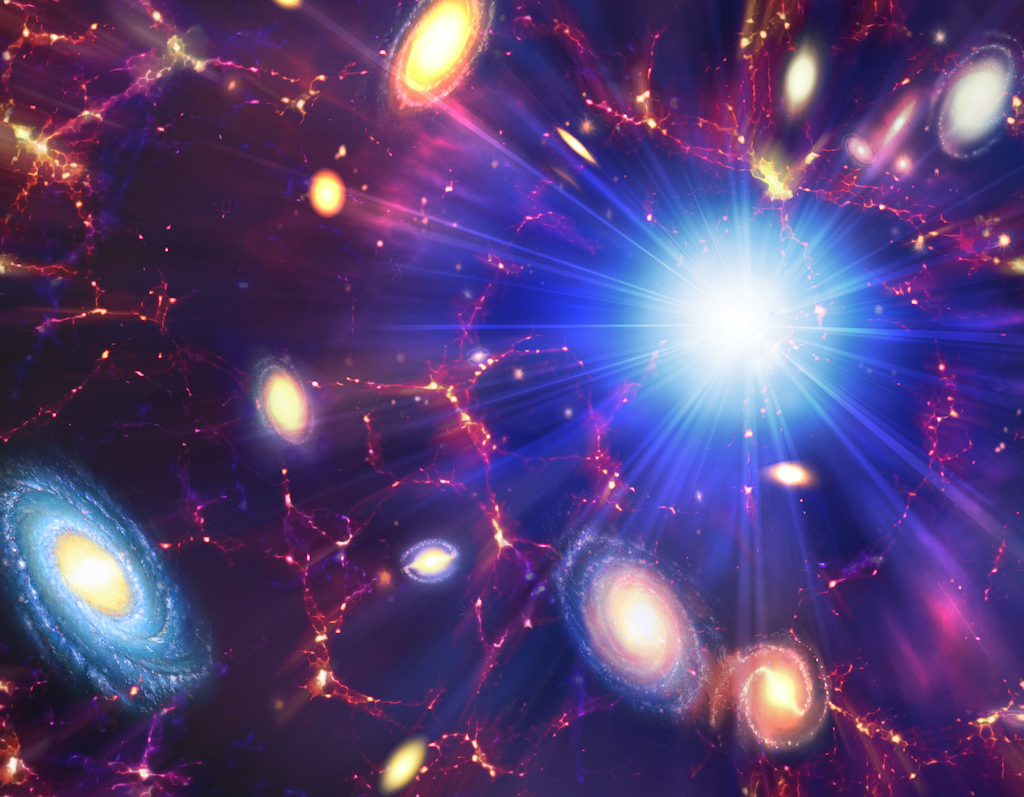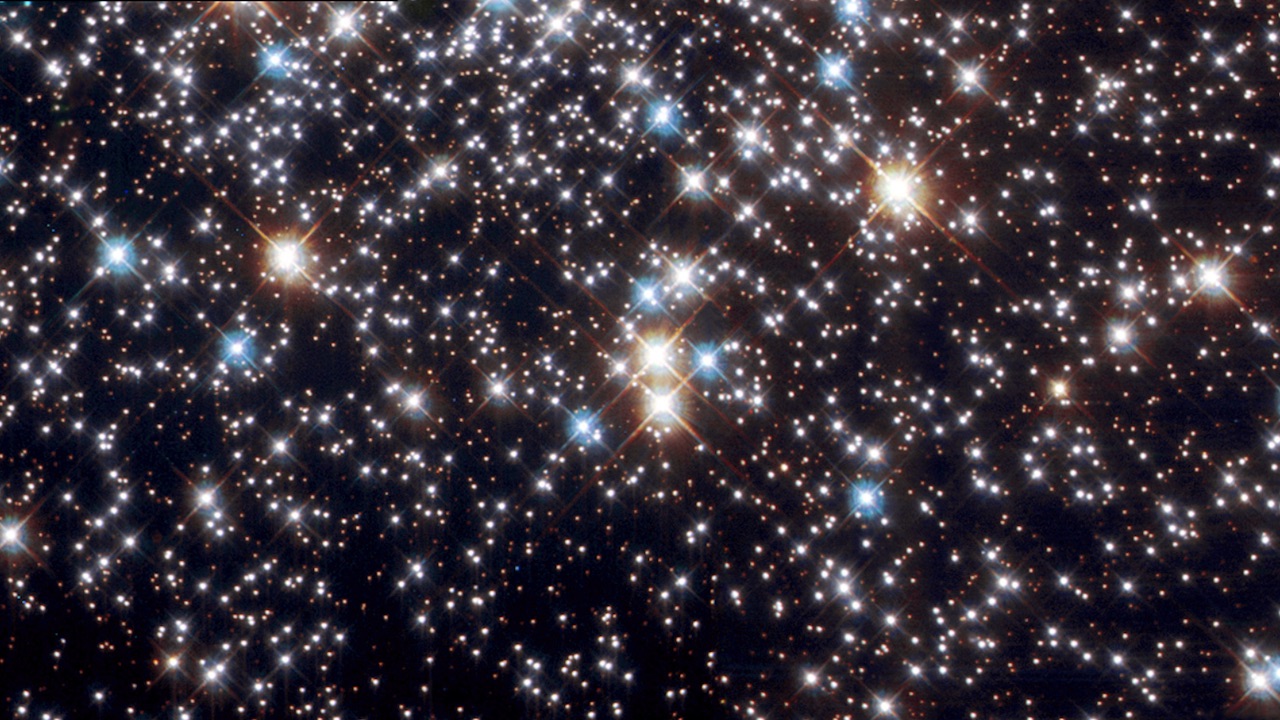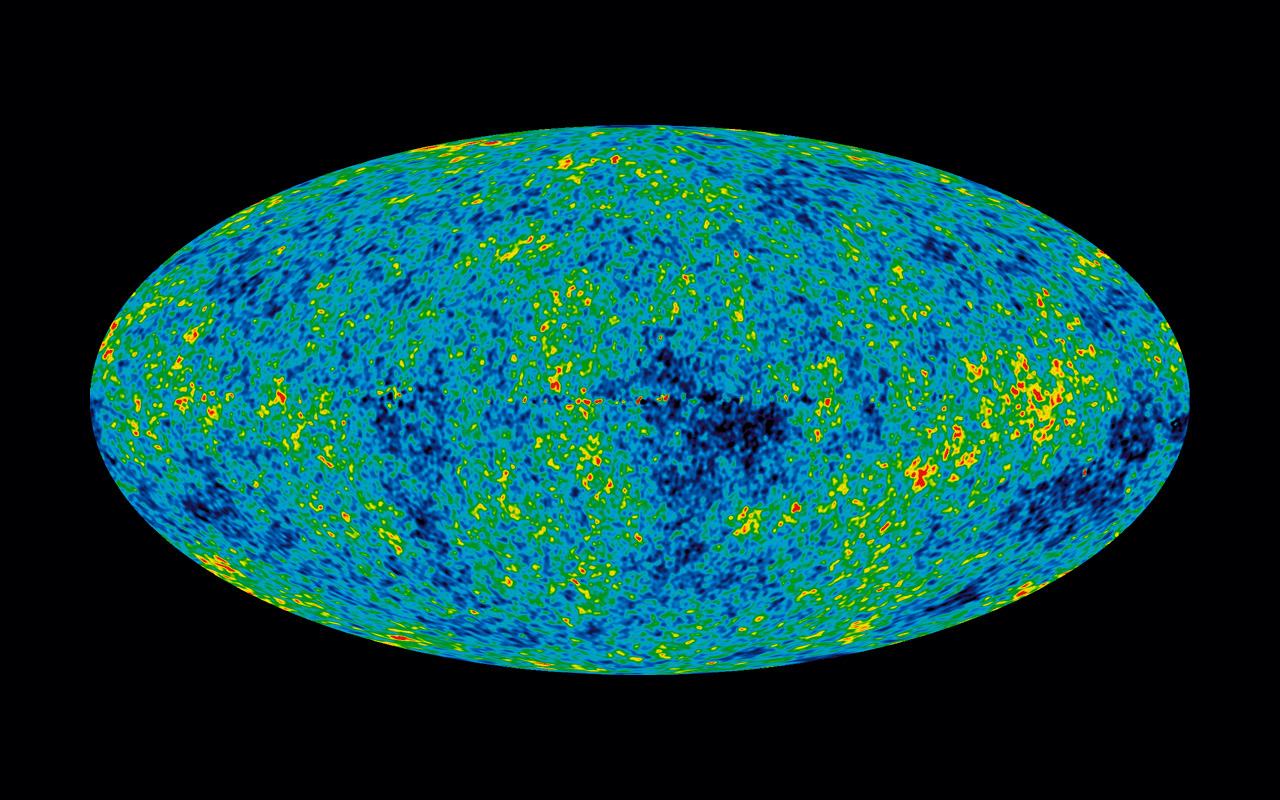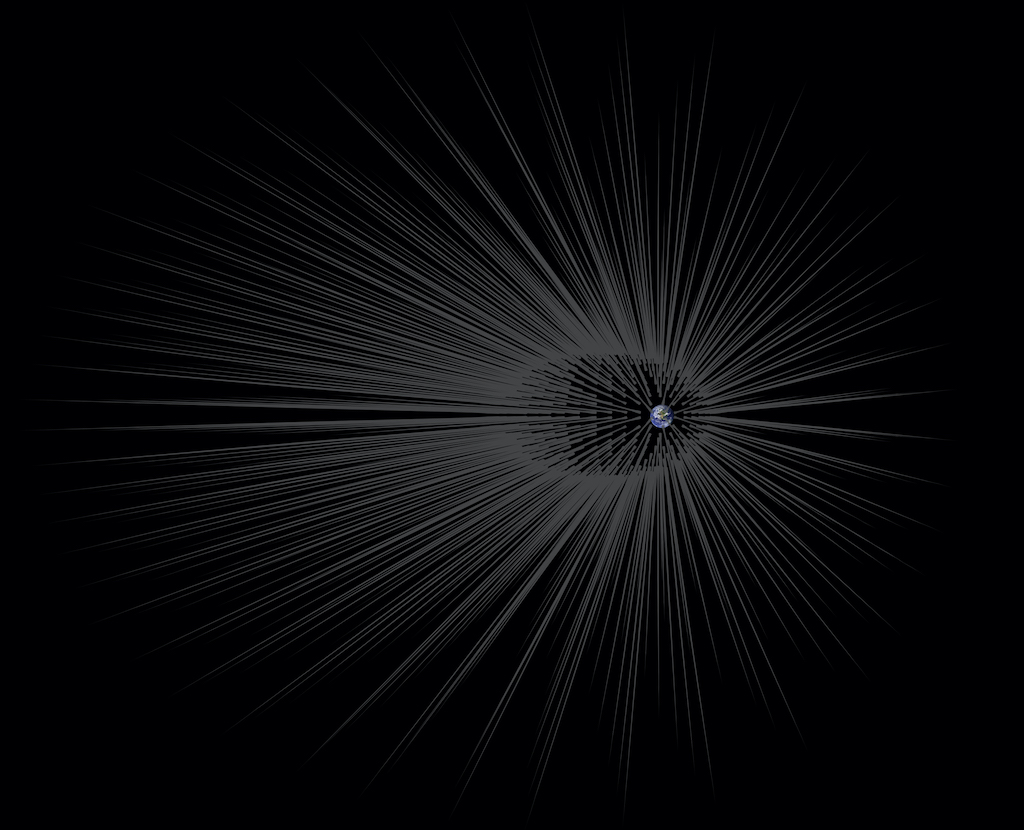The Big Bang
Most astronomers believe the Universe began in a Big Bang about 14 billion years ago. At that time, the entire Universe was inside a bubble that was thousands of times smaller than a pinhead. It was hotter and denser than anything we can imagine.
Then it suddenly exploded. The Universe that we know was born. Time, space and matter all began with the Big Bang. In a fraction of a second, the Universe grew from smaller than a single atom to bigger than a galaxy. And it kept on growing at a fantastic rate. It is still expanding today.
As the Universe expanded and cooled, energy changed into particles of matter and antimatter. These two opposite types of particles largely destroyed each other. But some matter survived. More stable particles called protons and neutrons started to form when the Universe was one second old.
Over the next three minutes, the temperature dropped below 1 billion degrees Celsius. It was now cool enough for the protons and neutrons to come together, forming hydrogen and helium nuclei.
After 300 000 years, the Universe had cooled to about 3000 degrees. Atomic nuclei could finally capture electrons to form atoms. The Universe filled with clouds of hydrogen and helium gas.
Last modified 20 June 2014
Story of the Universe
According to the big bang theory, billions of years ago the entire universe spanned an area of zero volume and infinite density. Then, this area expanded, doubling in size hundreds of times in less than a second. During those earliest moments, the universe was filled with energy, much of it in the form of intense heat. As the universe grew and cooled, some of this energy transformed into matter.
When we talk about the building blocks of matter, we usually concentrate on atoms. Atoms consist of a nucleus that contains at least one positively-charged subatomic particle called a proton. The nucleus might also contain one or more neutrally-charged particles called neutrons. Negatively-charged particles called electrons surround the nucleus, moving quickly around it within the confines of an energy shell.
But in the earliest stages of the big bang, atoms couldn’t form. The universe was too dense and hot. In fact, in the earliest moments of the first second of the big bang, even protons and neutrons couldn’t form. Big bang theorists believe the universe was full of subatomic particles like neutrinos, particles with no mass, or quarks, elementary particles that bond together to create larger particles like protons or neutrons.
Scientists call the force that holds quarks together to form larger particles the strong nuclear force. It’s so strong that under normal circumstances, we can’t observe quarks at all. That’s because the quarks bind together so tightly that we can’t separate them easily. For many years, the only proof that quarks even existed came from mathematical models of how the universe works. The models required the presence of particles like quarks in order to make sense.
Today, scientists have managed to take particles like protons and neutrons and break them down into quarks and gluons — particles with no mass that mediate the force between quarks. The quarks and gluons stay separated for only fractions of a second before decaying, but that’s long enough for scientists to observe them using powerful equipment.
How do scientists do this, and are they really recreating the big bang? Keep reading to find out.
The Big Bang in the Lab
The world of subatomic particle studies is paradoxical. Scientists use some of the world’s largest machines to study some of the smallest particles we know about. The devices they use are extremely sophisticated and precise, yet they rely on an almost violent approach. These methods and devices allow scientists to catch a glimpse of what the early universe might have looked like.
The way scientists look at the tiny particles of matter that make up subatomic particles like protons and neutrons is both elegant and primitive. They smash subatomic particles against each other really hard and look at the pieces that are left over. To do this, they have to use powerful machines called particle accelerators.
Particle accelerators shoot opposing beams of subatomic particles like protons at each other. Some accelerators are circular, while others are linear. They can be very big — circular accelerators can measure miles across in diameter. The accelerators use banks of magnets to accelerate the proton beams as they travel through tiny tubes. Once the proton beams reach a certain velocity, the accelerator guides them into a collision course. When the particles collide, they break apart into their component parts — such as quarks.
These subatomic particles decay in fractions of a second. Only by using powerful computers can scientists hope to detect the presence of a quark. In 2006, a team of scientists at the University of California, Riverside reported detecting a top quark, the most massive of the six kinds of quarks. The team had used a particle accelerator to cause a collision between a proton and an anti-proton. They detected the presence of the quark after it had already decayed. The decay process left an identifiable electronic signature [source: University of California, Riverside].
Does this mean scientists can recreate the big bang? Not quite. Instead, scientists hope they can simulate the condition of the earliest moments of the universe. That involves creating a hot, dense area of matter and energy. By studying these conditions, scientists might be able to learn more about how our universe developed. But they can’t recreate the period of rapid expansion that we call the big bang.
At least, not yet.
To learn more about the big bang and other scientific theories, take a look at the links on the next page.
Lots More Information
Related Articles
- How are astronomers able to measure how far away a star is?
- How Black Holes Work
- How Dark Matter Works
- How Galaxies Work
- How long can a human survive in outer space?
- How the Milky Way Works
- How NASA Works
- How Rocket Engines Work
- How Satellites Work
- How Stars Work
- Is there a hole in the universe?
More Great Links
- Bad Astronomy
- Ned Wright’s Cosmology Tutorial
Sources
- «Big Bang Theory — An Overview.» All About Science. http://www.big-bang-theory.com/
- Hawking, Stephen. «A Brief History of Time.» Bantam Books. New York. 1998.
- Hill, Karl. «NMSU researchers helping to re-create Big Bang conditions.» New Mexico State University. May 9, 2005. http://www.nmsu.edu/~ucomm/Releases/2005/may/phenix.htm
- Nave, R. «Quarks.» Hyperphysics, Georgia State University. http://hyperphysics.phy-astr.gsu.edu/hbase/Particles/quark.html
- Nebehay, Stephanie. «Physicists Recreation ‘Big Bang’ Conditions.» Space.com. Feb. 9, 2000. http://www.space.com/scienceastronomy/generalscience/physicists_bigbang_000209_wg.html
- Pittalwala, Iqbal. «UCR-Led Research Team Detects ‘Top Quark,’ a Basic Constituent of Matter.» University of California, Riverside. Dec. 13, 2006. http://www.newsroom.ucr.edu/cgi-bin/display.cgi?id=1477
- Shestople, Paul. «Big Bang Cosmology Primer.» University of California, Berkeley. December 24, 1997. http://cosmology.berkeley.edu/Education/IUP/Big_Bang_Primer.html
- Smoot, George F. «The Strong Nuclear Force.» Smoot Group. http://aether.lbl.gov/elements/stellar/strong/strong.html
- «Universe 101: Big Bang Theory.» NASA. http://map.gsfc.nasa.gov/universe/bb_theory.html
- Weiss, P. «Melting nuclei re-create Big Bang broth — quark-gluon plasma.» Science News. Feb. 19, 2000. http://findarticles.com/p/articles/mi_m1200/is_8_157/ai_60115120
- Wright, Edward L. «Cosmology Tutorial.» Retrieved June 2, 2008. Last modified May 27, 2008. http://www.astro.ucla.edu/~wright/cosmolog.htm
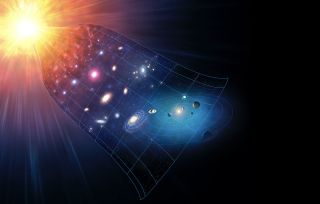
The universe was born with the Big Bang as an unimaginably hot, dense point. When the universe was just 10-34 of a second or so old — that is, a hundredth of a billionth of a trillionth of a trillionth of a second in age — it experienced an incredible burst of expansion known as inflation, in which space itself expanded faster than the speed of light. During this period, the universe doubled in size at least 90 times, going from subatomic-sized to golf-ball-sized almost instantaneously.
The work that goes into understanding the expanding universe comes from a combination of theoretical physics and direct observations by astronomers. However, in some cases astronomers have not been able to see direct evidence — such as the case of gravitational waves associated with the cosmic microwave background, the leftover radiation from the Big Bang. A preliminary announcement about finding these waves in 2014 was quickly retracted, after astronomers found the signal detected could be explained by dust in the Milky Way.
According to NASA, after inflation the growth of the universe continued, but at a slower rate (opens in new tab). As space expanded, the universe cooled and matter formed. One second after the Big Bang, the universe was filled with neutrons, protons, electrons, anti-electrons, photons and neutrinos.
During the first three minutes of the universe, the light elements were born during a process known as Big Bang nucleosynthesis. Temperatures cooled from 100 nonillion (1032) Kelvin to 1 billion (109) Kelvin, and protons and neutrons collided to make deuterium, an isotope of hydrogen. Most of the deuterium combined to make helium, and trace amounts of lithium were also generated.
For the first 380,000 years or so, the universe was essentially too hot for light to shine, according to France’s National Center of Space Research (Centre National d’Etudes Spatiales, or CNES). The heat of creation smashed atoms together with enough force to break them up into a dense plasma, an opaque soup of protons, neutrons and electrons that scattered light like fog.
Roughly 380,000 years after the Big Bang, matter cooled enough for atoms to form during the era of recombination, resulting in a transparent, electrically neutral gas, according to NASA (opens in new tab). This set loose the initial flash of light created during the Big Bang, which is detectable today as cosmic microwave background radiation. However, after this point, the universe was plunged into darkness, since no stars or any other bright objects had formed yet.
About 400 million years after the Big Bang, the universe began to emerge from the cosmic dark ages during the epoch of reionization. During this time, which lasted more than a half-billion years, clumps of gas collapsed enough to form the first stars and galaxies, whose energetic ultraviolet light ionized and destroyed most of the neutral hydrogen.
Although the expansion of the universe gradually slowed down (opens in new tab) as the matter in the universe pulled on itself via gravity, about 5 or 6 billion years after the Big Bang, according to NASA (opens in new tab), a mysterious force now called dark energy began speeding up the expansion of the universe again, a phenomenon that continues today.
A little after 9 billion years after the Big Bang, our solar system was born.
The Big Bang
The Big Bang did not occur as an explosion in the usual way one think about such things, despite one might gather from its name. The universe did not expand into space, as space did not exist before the universe, according to NASA (opens in new tab). Instead, it is better to think of the Big Bang as the simultaneous appearance of space everywhere in the universe (opens in new tab). The universe has not expanded from any one spot since the Big Bang — rather, space itself has been stretching, and carrying matter with it.
Since the universe by its definition encompasses all of space and time as we know it, NASA says it is beyond the model of the Big Bang (opens in new tab) to say what the universe is expanding into or what gave rise to the Big Bang. Although there are models that speculate about these questions, none of them have made realistically testable predictions as of yet.
In 2014, scientists from the Harvard-Smithsonian Center for Astrophysics announced that they had found a faint signal in the cosmic microwave background that could be the first direct evidence of gravitational waves, themselves considered a «smoking gun» for the Big Bang. The findings were hotly debated, and astronomers soon retracted their results when they realized dust in the Milky Way could explain their findings.
How old is the universe?
The universe is currently estimated at roughly 13.8 billion years old, give or take 130 million years. In comparison, the solar system is only about 4.6 billion years old.
This estimate came from measuring the composition of matter and energy density in the universe. This allowed researchers to compute how fast the universe expanded in the past. With that knowledge, they could turn the clock back and extrapolate when the Big Bang happened (opens in new tab). The time between then and now is the age of the universe.
How is it structured?
Scientists think that in the earliest moments of the universe, there was no structure to it to speak of, with matter and energy distributed nearly uniformly throughout. According to NASA (opens in new tab), the gravitational pull of small fluctuations in the density of matter back then gave rise to the vast web-like structure of stars and emptiness seen today. Dense regions pulled in more and more matter through gravity, and the more massive they became, the more matter they could pull in through gravity, forming stars, galaxies and larger structures known as clusters, superclusters, filaments and walls, with «great walls» of thousands of galaxies reaching more than a billion light years in length. Less dense regions did not grow, evolving into area of seemingly empty space called voids.
Contents of the universe
Until a few decades ago, astronomers thought that the universe was composed almost entirely of ordinary atoms, or «baryonic matter,» according to NASA (opens in new tab). However, recently there has been ever more evidence that suggests most of the ingredients making up the universe come in forms that we cannot see.
It turns out that atoms only make up 4.6 percent of the universe. Of the remainder, 23 percent is made up of dark matter, which is likely composed of one or more species of subatomic particles that interact very weakly with ordinary matter, and 72 percent is made of dark energy, which apparently is driving the accelerating expansion of the universe.
When it comes to the atoms we are familiar with, hydrogen makes up about 75 percent, while helium makes up about 25 percent, with heavier elements making up only a tiny fraction of the universe’s atoms, according to NASA (opens in new tab).
What shape is it?
The shape of the universe and whether or not it is finite or infinite in extent depends on the struggle between the rate of its expansion and the pull of gravity. The strength of the pull in question depends in part on the density of the matter in the universe.
If the density of the universe exceeds a specific critical value, then the universe is «closed (opens in new tab)» and «positive curved» like the surface of a sphere. This means light beams that are initially parallel will converge slowly, eventually cross and return back to their starting point, if the universe lasts long enough. If so, according to NASA (opens in new tab), the universe is not infinite but has no end, just as the area on the surface of a sphere is not infinite but has no beginning or end to speak of. The universe will eventually stop expanding and start collapsing in on itself, the so-called «Big Crunch.»
If the density of the universe is less than this critical density, then the geometry of space is «open (opens in new tab)» and «negatively curved» like the surface of a saddle. If so, the universe has no bounds, and will expand forever (opens in new tab).
If the density of the universe exactly equals the critical density, then the geometry of the universe is «flat» with zero curvature like a sheet of paper, according to NASA (opens in new tab). If so, the universe has no bounds and will expand forever, but the rate of expansion will gradually approach zero (opens in new tab)after an infinite amount of time. Recent measurements suggest that the universe is flat with only a 0.4 percent margin of error, according to NASA.
It is possible that the universe has a more complicated shape overall while seeming to possess a different curvature. For instance, the universe could have the shape of a torus, or doughnut (opens in new tab).
Expanding universe
In the 1920s, astronomer Edwin Hubble discovered the universe was not static (opens in new tab). Rather, it was expanding; a find that revealed the universe was apparently born in a Big Bang.
After that, it was long thought the gravity of matter in the universe was certain to slow the expansion of the universe (opens in new tab). Then, in 1998, the Hubble Space Telescope’s observations of very distant supernovae revealed that a long time ago, the universe was expanding more slowly than it is today. In other words, the expansion of the universe was not slowing due to gravity, but instead inexplicably was accelerating. The name for the unknown force driving this accelerating expansion is dark energy, and it remains one of the greatest mysteries in science.
Additional resources
Want to explore the universe for yourself? You can roam the Milky Way’s stars and galaxies virtually using NASA’s Hubble Skymap (opens in new tab). Additionally, you can read 10 wild theories about the universe (opens in new tab) in this article by Live Science.
Bibliography
«The first stars in the Universe». Monthly Notices of the Royal Astronomical Society: Letters, Volume 373, Issue 1 (2006). https://academic.oup.com/mnrasl/article/373/1/L98/989035?login=true (opens in new tab)
«The molecular universe». Reviews of Modern Physics (2013). https://journals.aps.org/rmp/abstract/10.1103/RevModPhys.85.1021 (opens in new tab)
«Hubble’s Law and the expanding universe». Proceedings of the National Academy of Sciences of the United States of America (2015). https://www.pnas.org/content/112/11/3173.short (opens in new tab)
Join our Space Forums to keep talking space on the latest missions, night sky and more! And if you have a news tip, correction or comment, let us know at: community@space.com.
Ailsa is a staff writer for How It Works magazine, where she writes science, technology, space, history and environment features. Based in the U.K., she graduated from the University of Stirling with a BA (Hons) journalism degree. Previously, Ailsa has written for Cardiff Times magazine, Psychology Now and numerous science bookazines.

